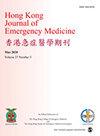Return of spontaneous circulation in patients with out-of-hospital cardiac arrest caused by pulmonary embolism using early point-of-care ultrasound and timely thrombolytic agent application: Two case reports
IF 0.8
4区 医学
Q4 EMERGENCY MEDICINE
引用次数: 0
Abstract
Introduction: Acute pulmonary embolism is a confirmed cause of up to 5% of out-of-hospital cardiac arrest and 5%–13% of unexplained cardiac arrest in patients. However, the true incidence may be much higher, as pulmonary embolism is often clinically underdiagnosed. Thrombolytic therapy is a recognized therapy for pulmonary embolism–associated cardiac arrest but is not routinely recommended during cardiopulmonary resuscitation. Therefore, clinicians should attempt to identify patients with suspected pulmonary embolism. Many point-of care ultrasound protocols suggest diagnosis of pulmonary embolism for cardiac arrest patients. Case presentation: We describe two male patients (60 years and 66 years, respectively) who presented to the emergency department with cardiac arrest within a period of 1 week. With administration of point-of care ultrasound during the ongoing cardiopulmonary resuscitation in both patients, fibrinolytic therapy was initiated under suspicion of cardiac arrest caused by pulmonary embolism. Both patients had return of spontaneous circulation; however, only the second patient, who received fibrinolytic therapy relatively early, was discharged with a good outcome. In this report, we discussed how to diagnose and manage patients with cardiac arrest–associated pulmonary embolism with the help of point-of care ultrasound. We also discuss the different clinical outcomes of the two patients based on the experience of the clinicians and the timing of thrombolytic agent application. Conclusions: If acute pulmonary embolism is suspected in patients with out-of-hospital cardiac arrest, we recommend prompt point-of care ultrasound examination. Point-of care ultrasound may help identify patients with pulmonary embolism during cardiopulmonary resuscitation, leading to immediate treatment, although the clinical outcomes may vary.早期护理点超声和及时应用溶栓剂治疗肺栓塞引起的院外心脏骤停患者的自发循环恢复:两例报告
急性肺栓塞是高达5%院外心脏骤停和5% - 13%不明原因心脏骤停的确诊原因。然而,真实的发病率可能要高得多,因为肺栓塞在临床上经常被误诊。溶栓治疗是公认的治疗肺栓塞相关性心脏骤停的方法,但在心肺复苏过程中不常规推荐。因此,临床医生应尝试识别疑似肺栓塞的患者。许多护理点超声方案建议肺栓塞的心脏骤停患者的诊断。病例介绍:我们描述了两名男性患者(分别为60岁和66岁),他们在一周内因心脏骤停而就诊于急诊科。在正在进行的心肺复苏期间给予护理点超声,在怀疑肺栓塞引起的心脏骤停的情况下开始了纤溶治疗。两例患者均恢复了自然循环;然而,只有第二名患者较早接受了纤溶治疗,出院时预后良好。在本报告中,我们讨论了如何在护理点超声的帮助下诊断和处理心脏骤停相关肺栓塞患者。我们还根据临床医生的经验和使用溶栓药物的时机讨论了两例患者的不同临床结果。结论:如果院外心脏骤停患者怀疑急性肺栓塞,我们建议及时进行即时超声检查。尽管临床结果可能不同,但在心肺复苏期间,点护理超声可以帮助识别肺栓塞患者,从而立即进行治疗。
本文章由计算机程序翻译,如有差异,请以英文原文为准。
求助全文
约1分钟内获得全文
求助全文
来源期刊

Hong Kong Journal of Emergency Medicine
EMERGENCY MEDICINE-
CiteScore
1.50
自引率
16.70%
发文量
26
审稿时长
6-12 weeks
期刊介绍:
The Hong Kong Journal of Emergency Medicine is a peer-reviewed, open access journal which focusses on all aspects of clinical practice and emergency medicine research in the hospital and pre-hospital setting.
 求助内容:
求助内容: 应助结果提醒方式:
应助结果提醒方式:


